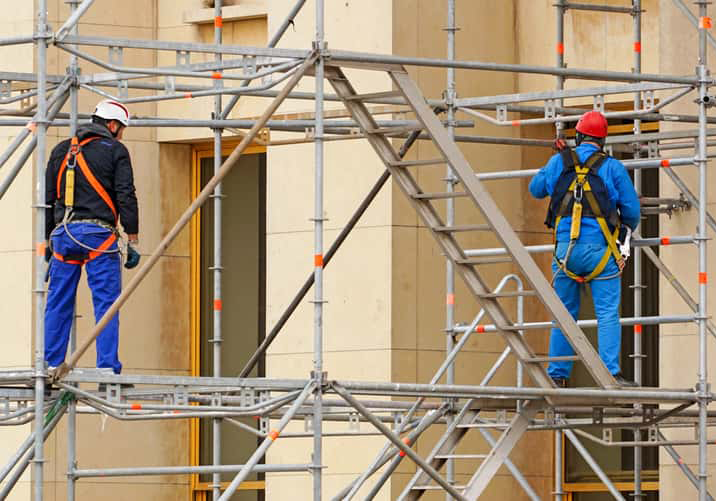-
أخر الأخبار
- استكشف
-
الصفحات
-
المدونات
-
Courses
-
الافلام
Domestic Scaffolding Services vs Commercial: What’s the Difference

Scaffolding is essential in construction, renovation, and maintenance, providing a safe working platform for tradespeople at height. But not all scaffolding is the same. When planning your next project, it's vital to understand the differences between Domestic Scaffolding Services and commercial scaffolding—two solutions that serve distinct purposes.
In this article, we’ll explore what sets them apart in terms of design, regulations, cost, and usage.
What Are Domestic Scaffolding Services?
Domestic scaffolding services are tailored for residential projects such as house extensions, roof repairs, gutter replacement, exterior painting, loft conversions, and chimney work. These scaffolds are typically smaller in scale and designed with convenience, safety, and homeowner needs in mind.
Key Features of Domestic Scaffolding:
-
Designed for single-family homes or small residential units.
-
Erected quickly to minimise disruption.
-
Focused on access and safety for tasks like window installation or roofing.
-
Complies with standard safety regulations but doesn’t require complex structural calculations.
Domestic scaffolding is ideal when easy access to rooftops, upper walls, or multi-storey homes is required. Homeowners often hire these services temporarily, depending on the size and duration of the project.
What Is Commercial Scaffolding?
Commercial scaffolding refers to more complex scaffolding solutions used on large-scale business premises such as office blocks, schools, shopping centres, factories, and industrial sites.
These setups are engineered to cover wide areas, multiple floors, and high-load capacities. Commercial scaffolding also requires detailed planning, compliance with stringent safety laws, and coordination with site managers and construction teams.
Common Uses for Commercial Scaffolding:
-
Large building construction and cladding.
-
High-rise window replacement and external repairs.
-
Long-term renovation or refurbishment projects.
-
Temporary roofing systems on large premises.
Because of the complex structures and risks involved, commercial scaffolding must follow strict guidelines under the Health and Safety at Work Act 1974 and Work at Height Regulations 2005 in the UK.
Key Differences Between Domestic and Commercial Scaffolding
Let’s break down the major differences between these two scaffolding types.
1. Project Scale and Scope
-
Domestic scaffolding supports small to medium-sized jobs, usually on two or three-storey homes.
-
Commercial scaffolding handles high-rise buildings, construction sites, and extensive repair projects that span multiple weeks or months.
2. Load Capacity
-
Domestic scaffolds bear limited loads—suitable for hand tools, paint cans, or lightweight materials.
-
Commercial scaffolding must accommodate multiple workers, heavy-duty equipment, and materials like bricks, timber, or steel.
3. Design and Engineering
-
Domestic systems use simpler, modular designs.
-
Commercial projects often require bespoke engineering plans, drawings, and load calculations by scaffolding design specialists.
4. Safety Regulations
-
While both must meet safety standards, commercial scaffolding must adhere to more comprehensive risk assessments, inspections, and method statements due to the public liability involved.
5. Cost and Time
-
Domestic scaffolding services are typically faster and cheaper to install.
-
Commercial scaffolding incurs higher costs due to the complexity, labour hours, and materials involved.
Choosing the Right Scaffolding for Your Project
Whether you’re a homeowner planning renovations or a contractor overseeing a large-scale construction job, choosing the right type of scaffolding is crucial.
For Homeowners:
If your goal is to repaint your house, fix your chimney, or carry out roofing work, domestic scaffolding services are likely the best fit. They’re:
-
Affordable
-
Quick to install
-
Non-disruptive to daily living
-
Customisable for home structures
For Business Owners or Builders:
If you're working on larger premises or multi-storey units, you’ll need commercial scaffolding with:
-
Enhanced stability and strength
-
Higher safety measures
-
Extended hire periods
-
Additional planning and coordination
It’s always wise to work with experienced scaffolding professionals who can guide you based on your site’s requirements.
Health and Safety Considerations
Safety should never be compromised in any scaffolding setup.
Domestic Safety Measures:
-
Platforms should have guard rails and toe boards.
-
Access should be via secure ladders or stair towers.
-
Regular checks must be performed, especially after bad weather.
Commercial Safety Protocols:
-
Site-specific risk assessments are mandatory.
-
Only trained operatives (PASMA certified) should erect and dismantle scaffolds.
-
Scaffolding tags and inspection logs must be maintained throughout the job.
Failure to comply with safety protocols can result in accidents, legal penalties, and project delays—making professional service essential for both domestic and commercial users.
Benefits of Hiring Professionals for Domestic Scaffolding Services
Even small-scale scaffolding demands expert knowledge. Here’s why hiring a professional domestic scaffolding company matters:
-
Safety First: Reduced risk of falls or injuries.
-
Compliance: Ensures adherence to building and HSE guidelines.
-
Efficiency: Quick setup and takedown to keep your home project on track.
-
Peace of Mind: Workmanship is guaranteed, and insurance is covered.
Look for companies with excellent reviews, up-to-date insurance, and familiarity with local planning permissions.
Final Thoughts
While domestic scaffolding services and commercial scaffolding serve a similar fundamental purpose—safe access at height—their applications, designs, and safety requirements differ greatly.
Domestic scaffolding is ideal for residential renovations and smaller jobs, offering flexibility and cost-efficiency. On the other hand, commercial scaffolding is a more complex, large-scale solution suited for industrial and business environments with higher safety demands and engineering considerations.
Before hiring a scaffolding company, consider the scale, complexity, and legal responsibilities of your project—and always opt for a certified and insured scaffolding contractor.
- Art
- Causes
- Crafts
- Dance
- Drinks
- Film
- Fitness
- Food
- الألعاب
- Gardening
- Health
- الرئيسية
- Literature
- Music
- Networking
- أخرى
- Party
- Religion
- Shopping
- Sports
- Theater
- Wellness


